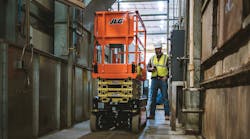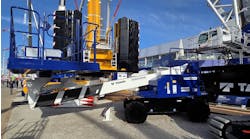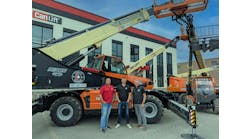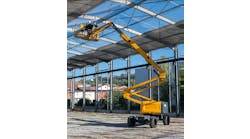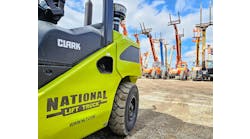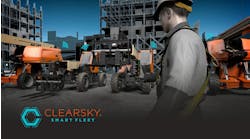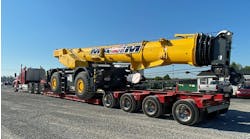What are the latest safety developments from your company?
With a core focus on improving job site safety, we are always looking to develop enhancements that make JLG equipment safer and more intuitive to operate. Two new technologies we’ve recently introduced are SkySense for boom and scissor lifts and JLG Mobile Control for scissor lifts.
SkySense is an enhanced detection system that uses strategically placed object detection sensors to provide operators an added level of awareness of their immediate surroundings. When a machine is in use, the sensors establish warning zones and stop distances in the machine’s direction of motion. As the machine approaches the zone limits, audible alerts notify the operator, increasing protection of people and property.
Mobile Control allows you to drive, steer and load a stowed JLG scissor lift from a mobile device. When you purchase a scissor with mobile control, you can operate your scissor from up to a 40-foot distance with Bluetooth enabled technology, allowing better visibility of possible obstructions while maintaining a safe distance from the machine. You can position your machine into tight spots or navigate through areas with low clearance from outside, and away from, the platform and you can load your machine onto trucks at the end of the work day with ease, from the ground, at a safe distance from the truck and the machine.
On a machine equipped with JLG Mobile Control hardware, you simply download the JLG Mobile Control app; open the app and scan the machine-specific QR Code on the machine; then use the app to drive and steer your machine.
What impact has COVID-19 had on your business and what do you expect going forward?
Entering the year 2020, JLG anticipated a slight decline in global demand for aerial equipment with a headwind moving into 2021. In general, our outlook was positive, and our forecast aligned to the cyclical nature of the business which is something we plan for.
What we did not anticipate, was a global health pandemic that would rapidly impact the global economy in ways no one could have predicted. The situation required quick, decisive action to protect the health and safety of our employees, our customers, and the business to prevent the spread of COVID-2019.
We believe it is JLG’s responsibility as the access industry leader to navigate today’s business climate with both courage and compassion. That means keeping our 6,000+ JLG employees and the company’s people first culture at the forefront of all our decisions and actions, while retaining strong partnerships with our suppliers and customers.
While working to protect and support our employees and our communities; we have of course kept a fiscally responsible eye on the business. As with most companies, we’ve seen order delays and a handful of cancellations; all to be expected given the magnitude of the global situation. As hotspots for the virus took hold in key cities and construction sites began to close, we worked quickly to understand supply chain health and changing utilization rates.
Our team worked with incredible agility to scale back operations, while maintaining an acute focus on taking care of our customers. I think it is fair to say that this combination of priority efforts has resulted in company performance above what we’ve seen reported by others in the industry.
From experience, we have learned that some of the biggest risks to a speedy recovery is not having the right people or inventory in place. To ramp up quickly requires a healthy ecosystem. This has helped guide our pragmatic and balanced approach to align supply chain availability with customer demand, while retaining team members.
Our employees are our number one asset. They are the reason we have delivered several years of consecutive growth. They are the reason we have latitude with our supply chain partners and they are the reason we have strong relationships with our customers. When all these things align, it allows a company to emerge healthier and faster on the back end.
What have been the latest developments in your company’s product line in the past year?
As a company, we are working at elevating the access industry and our product line in three core areas: safety, productivity, and technology. We listen to the needs of our customer then innovate based on their input. We call this customer inspired innovation and it drives everything we do. We touched on a few of the newest safety features above, so I’ll focus on product and technology here.
Our signature launch at ConExpo 2020 was our 670SJ Self-Leveling Boom Lift. JLG engineers recognized that traditional boom lifts were designed for the near ideal conditions of firm, flat surfaces. Since the world is neither flat, nor does much of it come with improved surfaces, they began exploring the viability of a boom lift with a smart suspension. The result is our new 670SJ Self-Leveling Boom, which allows the boom to traverse uneven ground up to 10-degrees, while keeping the chassis level. This results in decreased platform movement during travel for greater operator comfort and confidence and full functionality while driving at height for greater productivity.
The JLG line of HC3 (high capacity) boom lifts offer an expanded work envelope and three capacity zones for greater reach than comparable models. Thus far we have released 40 foot, 60 foot, and 80 foot models. Each offers an unrestricted capacity zone, plus two restricted capacity zones – allowing operators to bring more tools, material, and people to the work area. All JLG hi-capacity boom lifts are rated for three occupants in all three zones.
On the telehandler front, customers told us they wanted a 10,000-pound telehandler with greater height and reach. We developed the JLG 1075, 75-foot boom, 8-story lift height telehandler as a result. It delivers a full two stories more lift height than comparable models and offers a 60-foot reach so operators can place materials exactly where they are needed, minimizing re-handling. This new telehandler has the advantages of a crane without the high, associated rental and assembly costs. New attachments like our sheet material handler make it even more versatile, as it allows the unit to reach further into buildings to improve productivity.
We’ve got quite a few new scissor offerings. I’ll address our new all-electric scissor in your electrification question below and focus here on our new line of rough terrain and electric rough terrain lifts which roll off our production line in October.
This new family of scissors is 69 inches wide, and comes in 26-, 33-, 40- and 47- foot platform heights. All boast an industry leading platform size, with the ERT 4769 being the tallest scissor in its size class. The 47-foot platform height on the RT4769 and ERT4769 provide up to a 5-story work height, a feature that is becoming more and more important as buildings become more vertical in nature.
All models are available with a diesel engine or a battery power source and electric drive and come with several productivity-enhancing features, including indoor/outdoor drive at height capabilities. This feature is particularly useful in warehouse construction, which requires installation of utilities at a fixed height across the length of a building.
LiftSense, an evolution of JLG variable tilt, monitors both the weight in the platform and the machine’s tilt to determine the allowable work envelope. This new and industry-first feature notifies the operator prior to raising the machine how high they can elevate, removing the guesswork that often results in having to descend and try again. QuikLevel Advanced allows the stowed scissor to level on a side slope up to 5° with driving at full height allowed under certain conditions. This is especially beneficial when performing work at height along the outside of a building that has been graded for drainage at a consistent slope.
These new rough terrain scissors also include the industry’s first LCD platform control box. This intuitive display delivers a multitude of productivity, terrain, machine health and safety notifications to the operator during use.
From a technology standpoint we are looking beyond what is incorporated into the product. We are working to develop digital solutions and tools that are useful on the job site to further improve safety and productivity.
One example is our new Augmented Reality (AR) App, which delivers data through five modules to help customers plan projects more accurately. The five modules include machine visualization, kit visualization, operational guidance, a decal viewer and inspection assistance. The visualization tools allow the user to choose the right equipment and/or accessory for the job by placing and moving a virtual machine or accessory onto a machine in an actual work environment. The operational guidance and decal viewer help users understand the machine controls and decals in their local language, while the inspection assistant provides historical inspection data specific to the machine.
And last, but not least, is the extension of our virtual reality training with AccessReady Fusion XR. This new offering combines JLG’s original boom lift training simulator with a full scissor lift training package, giving operators the opportunity to become familiar with each MEWP type and its controls prior to stepping into an actual machine.
AccessReady Fusion XR provides an immersive, virtual reality-based training for users of all skill levels. Instructors can create their own scenarios designed to test various skills and select the criteria for evaluation of user performance. As you can see, JLG’s commitment to advancing training either in-person, online or virtually remains as strong as ever.
What have been the most important recent trends in aerial product development and what trends look most important in the near future?
Connected and sustainable technologies, as well as an increasing demand for compact equipment and on the other end of the spectrum, higher capacity equipment are just a few of the trends we have seen. These trends are driven by things like electrification, urbanization, and the productivity imperative. People are being asked to do more with less, in tighter spaces, under stringent time and budget demands in a manner that is minimally disruptive to the environment. Equipment manufacturers will need to continually evolve and introduce technologies and features that allow customers to be successful in these areas.
Now that new ANSI standards have become a reality, how would you assess the impact they are having so far? How are customers adapting to newer machines with load-sensing technology, terrain-sensing, indoor/outdoor restrictions and so on?
Our philosophy to regulatory compliance, whether it's ANSI or others, is to do more than merely satisfy the requirements. Based on the numerous delays to the effectivity date of the recent ANSI standard updates, we had plenty of time to plan for, test and even evolve the equipment design changes required to meet the new A92 suite of standards, including load and terrain sensing and indoor/outdoor restrictions. This gave JLG the opportunity to confidently bring to market what we feel are industry leading modifications that add tangible value to our customers.
In short, I’d say that because we approached the design changes noted above individually, with the user in mind and an eye towards improving productivity and safety, that customers have been eager to stock JLG A92 compliant units.
As the new standards became imminent, our organizational focus shifted from equipment modifications to educating our customers and the industry about the new standards. We continue to do so today.
One question our sales team is frequently asked by rental companies regarding the new standards relates to training: “How do I get my customer (the end user) certified?” This falls under A92.24 which covers MEWP training materials, defines how theoretical and practical training should be delivered and identifies required elements for proper training and familiarization.
Specific changes under this section of the standard relative to rental companies requires that all training be delivered by a qualified person who is experienced with the classification of MEWP on which the training is being given. This qualified training provider must be knowledgeable about the laws, regulations, safe use practices, manufacturer’s requirements and recognition and avoidance of hazards as they relate to MEWPs.
While MEWP operator training remains mandatory under the new standard, it now extends beyond operators to include others who will come in contact with a MEWP on the job site, including: Supervisors and people who directly supervise MEWP operators and Occupants: People in the MEWP platform who are not considered operators.
As the industry leader, we feel it’s our obligation to continue to talk about and educate the industry on the impact of these new standards in all three areas: machine design, safe use and training.
What level of demand are you seeing for electric MEWPs, hybrids, alternative fuels?
JLG is no stranger to hybrid and electric MEWPs. Our first hybrid model was introduced more 23-years ago. In recent years, there’s been increasing demand for both hybrid and electric machines. With the construction industry typically being a fast follower of the automotive industry, we are taking cues from the increasing number of electric cars on the road. We anticipate a similar increase in demand for electrified heavy equipment globally in the near future.
That said, many manufacturers, including JLG, have offered electrified features and battery powered units for many years. The JLG line of electric drive, ES series scissors for example, are battery powered and have long been considered the industry benchmark for performance due to fewer hydraulics and up to double the battery life vs. standard hydraulic drive models.
That said, our latest scissor lift introduction, the AE (All Electric)1932 Davinci model is fully electric and the first of its kind. Every component of the machine is optimized, allowing it to be powered with a single lithium-ion battery without a compromise to performance. It even recovers energy while the platform is being lowered, which contributes to a 70-percent decrease in power consumption and a longer battery life per charge.
Its single lithium-ion battery is backed by a class-leading warranty and is expected to last 120-plus months, so owners should never have to replace a battery during the machine’s lifespan.
Customers asked JLG to develop a scissor that minimized leaks and lowered after-the-sale maintenance costs. The AE1932 Davinci doesn’t just contain leaks, it eliminates them altogether, and with zero hydraulics, there are no potential leak points.
The AE1932 Davinci offers a 20 percent greater, 600-pound platform capacity both indoor and out, travels 2 times faster and charges 3.5 times faster than a standard lift. Each wheel is controlled independently to reduce tire wear and limit damage to sensitive flooring. It is a progressive, environmentally friendly, yet productive solution that eliminates common scissor lift job site challenges.
How do you see adoption of telematics systems changing the rental industry?
Adoption to technologies that improve the efficiency and safety of operations continue to gain momentum. Telematics have been around for quite a while at this point; however, they continue to evolve in a manner that provides increasingly useful and tangible real-time data to equipment owners and operators. The data these systems provide, along with other connected technologies simplify logistics and allow for the proactive management of equipment fleets for optimal utilization and minimal downtime. They are a win-win for rental companies and end-users alike.
